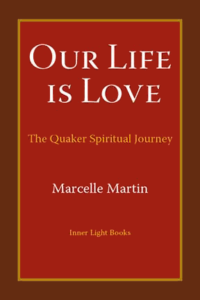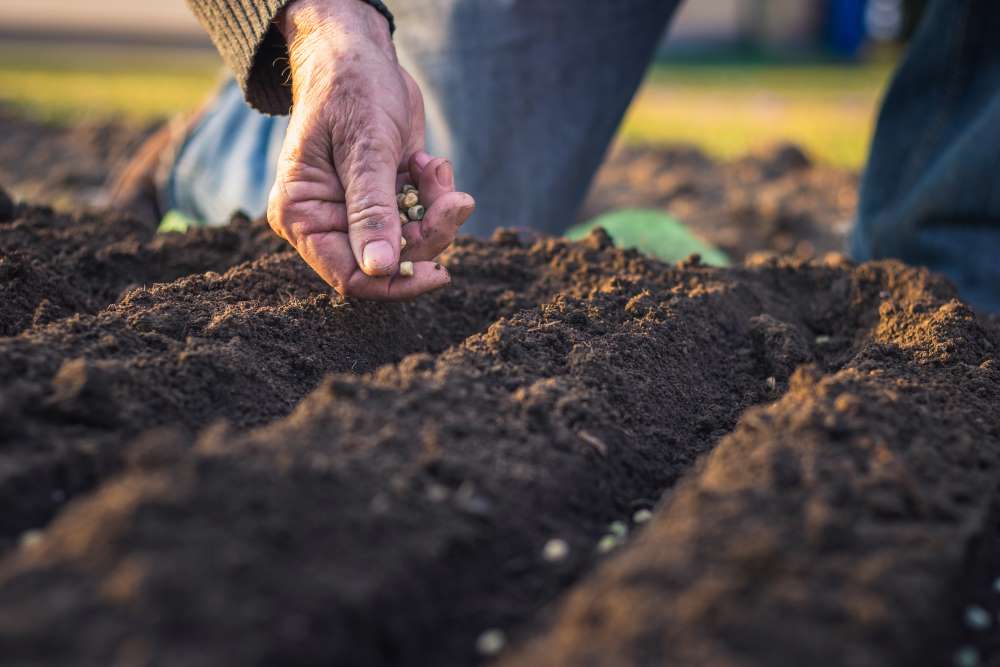Our Life Is Love: The Quaker Spiritual Journey
Reviewed by Marty Grundy
August 1, 2016
 By Marcelle Martin. Inner Light Books, 2016. 230 pages. $30/hardcover; $17.50/paperback; $10/eBook.
By Marcelle Martin. Inner Light Books, 2016. 230 pages. $30/hardcover; $17.50/paperback; $10/eBook.
Buy from Quakerbooks
Marcelle Martin, known to many for her work at Pendle Hill study center in Wallingford, Pa., and as a retreat leader, author, and blogger, identifies ten “essential elements” of Quaker spiritual life. They are true for a spiritual journey in virtually any faith tradition, although the vocabulary she uses is Christian and Quaker. She provides stories and apt quotations from early Friends, followed by stories and quotations from contemporary Friends to illustrate each element.
The elements are grouped in three clusters: Awakening, Convincement, and Faithfulness. Each of them is a part of the process, but they are not linear, nor is one ever completed and checked off as finished. The metaphor is one of many strands being braided together to make a strong cord, or of circling around and revisiting elements again and again through life.
The adventure begins with awakening. We must be hungry before we can be fed. The elements that begin the process are longing, seeking, and turning within. Early Friends’ journals make this hunger very clear, usually having to do with anxiety over their salvation, desperation for a closer relationship with God and Christ, and obsession about their sins. Today our longing is often described in other ways: loneliness, meaninglessness, or anomie. We seek for “More.” And we begin to find what we seek by turning within.
The second set of elements is convincement, with the old meaning of being convicted as in a court of law. There are “openings,” receiving new understanding about one’s own condition, and our complicity in the unjust and unsustainable systems in which we are enmeshed. There is the “refiner’s fire,” the Light showing us those parts of ourselves that are out of alignment with love, and our need to change and be changed. This involves pain and hard work. This grouping also involves community, as we learn together to allow God to gather us into spiritual community, helping one another and being melded into a place of transformation, and finally, “a place of obedience, a community of faithfulness.”
The third set is faithfulness: learning to live transformed lives. Leadings must be paid attention to, and carefully discerned. The Cross was—and is—a critical part of Quaker spiritual living. Martin defines it as making “sacrifices that our limited human will would prefer not to make, and to do so for the sake of God’s greater purposes.” Abiding includes trusting in the power that comes from being rooted in Christ’s love, and having faith in divine providence, that way will open. The tenth element is perfection, the word we so easily misunderstand. Early Friends experienced it as they “surrendered their small selves and united with the divine Fountain of Love.” It is not so much an element of the journey as a state toward which God draws all of us. The Greek word can also be translated as “wholeness” or “completion” or “maturity.” “Wholeness comes when something larger and wiser than the self has taken control, when God becomes the active force in a person’s life and any goal other than loving faithfulness has fallen away.”
Martin uses biblical language and metaphors that were very meaningful to early Friends and can become filled with meaning for Friends today who choose to travel this path. But the language is not the important thing. What is crucial is the experience. This is not “Quaker lite,” the idea that the highest value for Friends is tolerance, that one can believe anything or nothing. This book points to the real thing, a path that is narrow and difficult, requiring surrender and the Cross, while promising unimaginable joy, healing, and freedom within all-encompassing love.
Martin includes a sketch of her own experience with these ten elements. Having been transformed in many ways, she is embodying her Quaker faith rather than merely proclaiming it. We are invited to do the same—remembering that although each of us must do our own personal work with the Light, our path is also deeply communal. We need a “community of accountability to guide and shepherd” one another into the great work to which God is calling us.
Martin has glimpsed that God has a purpose for Friends in the great work of healing and reorienting human life on earth in this time of impending crisis. But in order to be a useful tool for divine purposes, we must individually and as a faith community surrender our self-importance, our need to control, our egos, and our fears. We must wholeheartedly move toward the surrender of our “small selves” so that “we can be guided by the Light in everything we do.” Martin concludes, “Only God can do what is needed in our time, and God will only do it through a willing humanity aware of its interconnections with other people, the planet, and all that is Holy.”
The book contains recommended resources and a bibliography. Each of the ten elements concludes with thought-provoking, searching questions that can be used by an individual or by a group willing to dive deeply together. I wholeheartedly recommend this book for any Friend or meeting that yearns for the heart of Quaker faith and practice, summed up here by paraphrasing William Penn: that we must be changed ourselves before we can change the world.



Comments on Friendsjournal.org may be used in the Forum of the print magazine and may be edited for length and clarity.